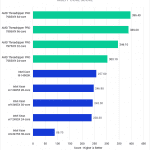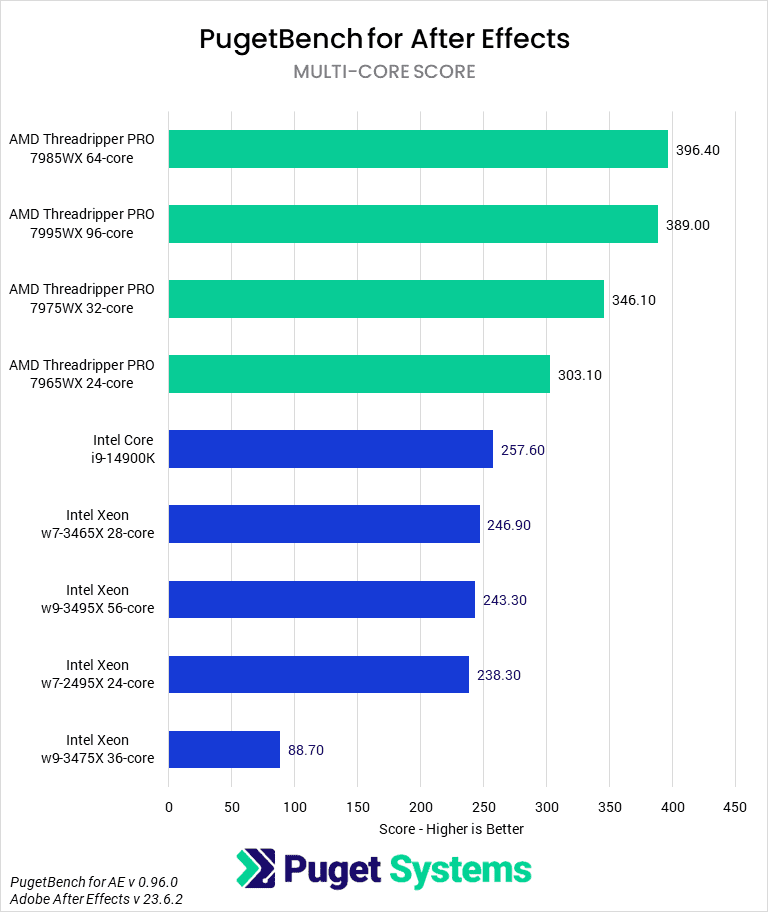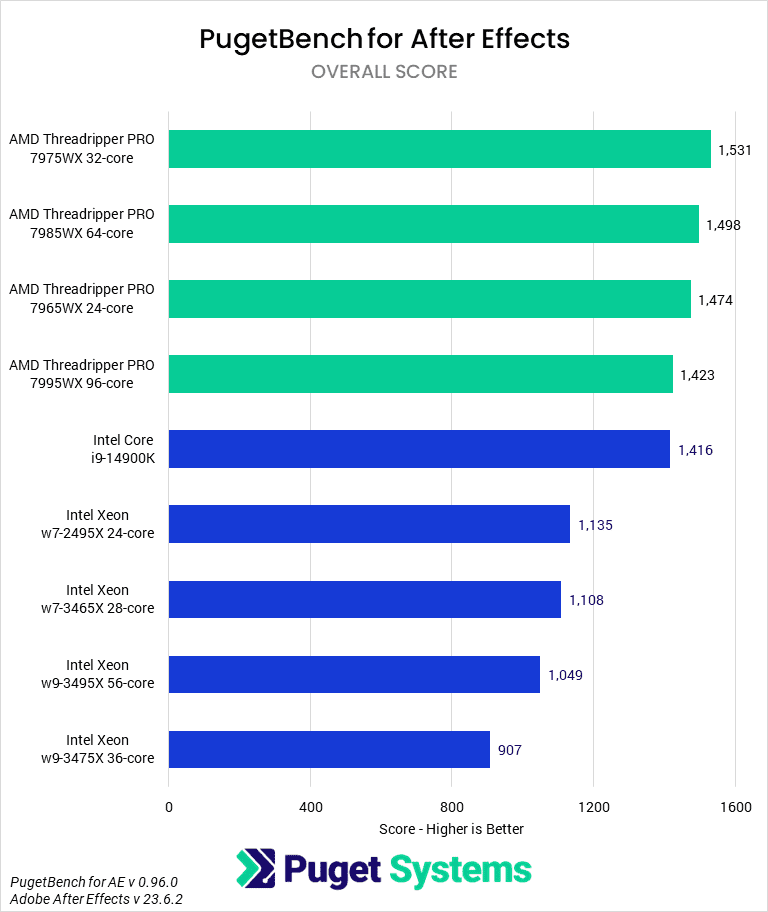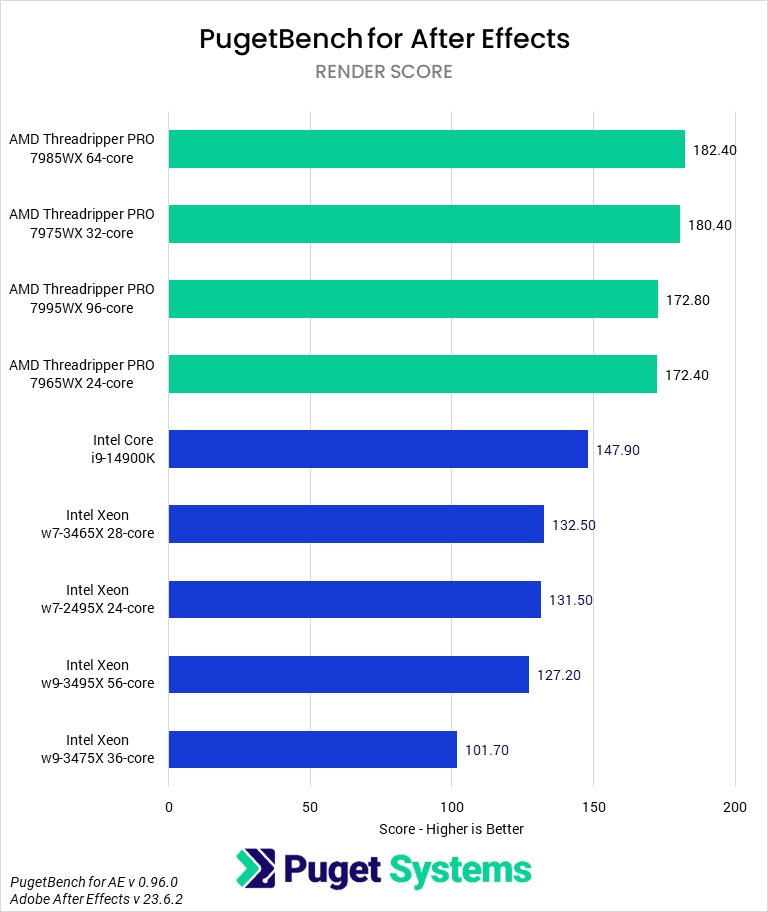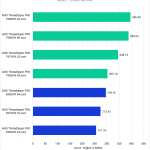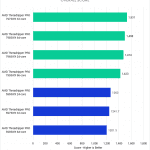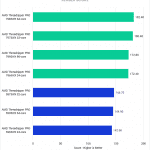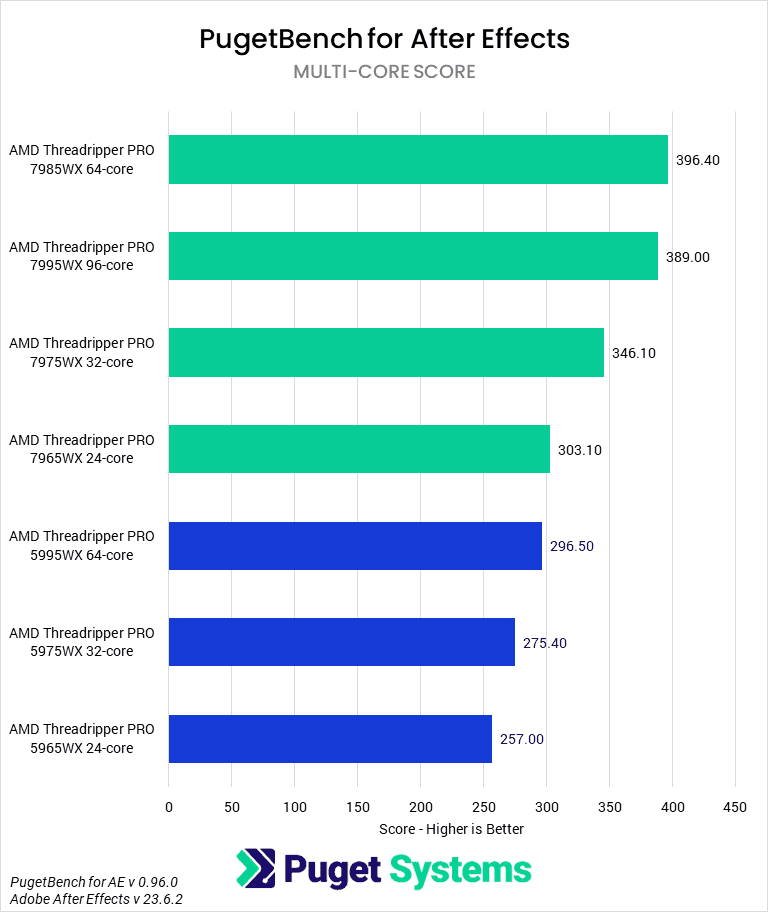Table of Contents
TL;DR: AMD Threadripper PRO 7000 WX-Series Performance in After Effects
Overall, the new AMD Threaripper PRO 7000 WX-Series processors do extremely well in Adobe After Effects, although whether they are worth the investment is going to be determined by the type of projects you work with. For complex projects that benefit from having a CPU with lots of raw compute power, the new AMD Threadripper PRO 7000 WX-Series is stellar, offering anywhere from 30-60% more performance than an Intel Xeon W-3400 processor. They are also about 20-30% faster than the previous generation Threadripper PRO 5000 WX-Series, meaning that a single-generation upgrade may be worth it even if you have a relatively modern workstation.
We will note that the Threadripper PRO 7000WX processors are only about 5% faster than the standard Threadripper 7000 models (as we show in our AMD Threadripper 7000 vs AMD Threadripper PRO 7000WX for Content Creation article). However, if your projects are extremely long, the additional RAM capacity of Threadripper PRO – which easily allows for 512GB of RAM, and can go as high as 1TB – can be a massive benefit. It is likely overkill for 99% of users, but having enough RAM can be the difference between being able to smoothly play through a cached composition, and needing to wait for each frame to re-render since the cache had to be deleted from RAM Preview to make space.
Introduction
Adobe After Effects is always interesting to look at when there is a new CPU launch because the right processor depends heavily on the type of projects you work on. Most users will be served well with a consumer platform like Intel Core or AMD Ryzen since they can perform well and typically allow for 128GB of RAM. However, for After Effects power users who work with especially complex and lengthy projects, upgrading to AMD Threadripper or Threadripper PRO can give terrific returns on investment due to their raw compute power and the amount of system RAM that can be used.
With this generation, AMD has split their high core-count CPUs into two separate product families: the High-End Desktop (HEDT) AMD Ryzen Threadripper 7000 Series, and the even higher tier AMD Ryzen Threadripper PRO 7000 WX-Series. Both are based on AMD’s Zen 4 architecture, which means they support new technologies like PCI-e Gen 5.0 and DDR5 memory, but the “PRO” line includes twice the number of memory lanes (8 channel vs 4 channel) and more than twice the number of PCIe lanes (128 vs 48). In addition, the higher line also includes a 96-core processor for those workloads that benefit from having a massive number of CPU cores.
While the difference in memory channels (and thus the maximum RAM they support) may come into play in a few niche After Effects workflows that need more than 512GB of RAM, in terms of straight performance we don’t expect to see anything significantly different with the Threadripper PRO 7000WX processors than we did in our recent review of the Threadripper 7000 line. With that said, we have a dedicated AMD Threadripper 7000 vs Threadripper PRO 7000WX for Content Creation article if you want to see exactly where it may make sense to invest in the PRO line, and where the normal Threadripper is a better fit.
In this article, we want to focus on the performance of the Threadripper PRO 7000 WX-Series compared to the previous generation Threadripper PRO 5000WX and the Intel Xeon W-2400/3400 line from both a pure performance standpoint, and their ROI based on price-to-performance. In addition to Threadripper PRO and Xeon, we will also include the Intel Core 14900K to provide some context for how AMD Threadripper PRO compares to a more typical CPU choice for this type of workload.
Because there are so many CPUs to examine, we will break our analysis down into Intel vs AMD (AMD Threadripper PRO 7000WX vs Intel Xeon W-3400) and performance versus the previous generation (AMD Threadripper PRO 7000WX vs AMD Threadripper PRO 5000WX)
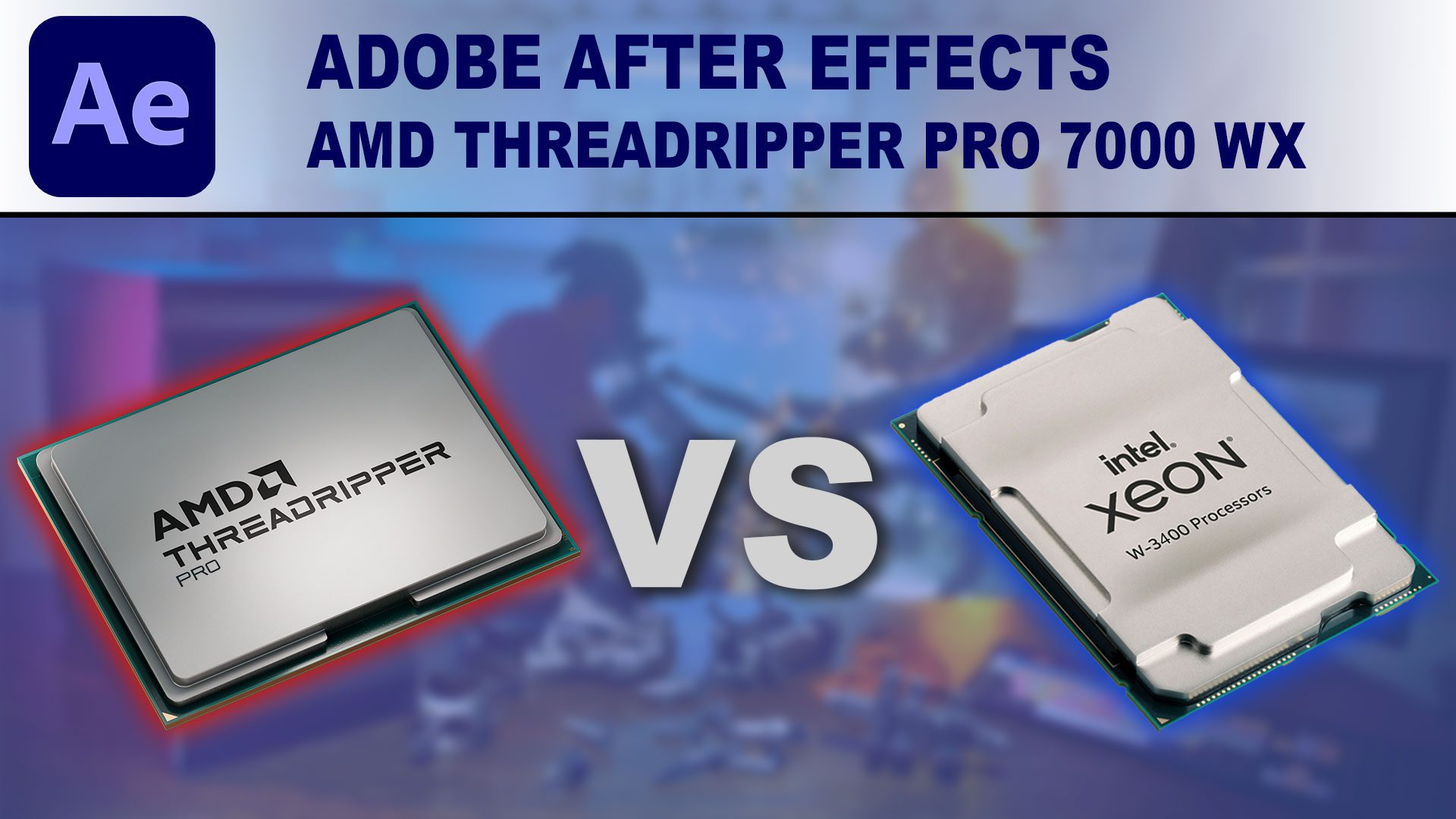
To learn more about how the new AMD Ryzen Threadripper PRO 7000 WX-Series processors perform in other workflows, we have compiled an overview in our AMD Ryzen Threadripper PRO 7000WX Content Creation Review article. That post also includes more detailed information on the CPU specifications and test results for various applications: Photoshop, Lightroom Classic, DaVinci Resolve, Premiere Pro, Unreal Engine, Cinema 4D, Blender, and V-Ray.
In addition, although all the new AMD CPUs have a TDP of 350 W, TDP is rarely the whole story. To see how much power these chips use to complete tasks, check out our Power Analysis: AMD Ryzen Threadripper 7000 article. That is specifically looking at the non-Pro models, but both Threadripper lines have the same power draw and can be considered interchangeable when it comes to CPU power draw and cooling.
Raw Benchmark Data
We design our benchmarks to cover many workflows and tasks to provide a balanced look at the application and its hardware interactions. However, many users have more specialized workflows. Recognizing this, we like to provide individual results for benchmarks as well. If a specific area comprises most of your work, examining those results will give a more accurate understanding of the performance disparities between components.

AMD Threadripper PRO 7000WX vs Intel Xeon W-3400 for Adobe After Effects
After Effects has several different aspects and workflows that dictate how it uses the hardware in your system. In most cases, it is CPU-bound but ranges from being lightly threaded, where a CPU with high per-core performance is best, and moderately threaded, where a CPU with a high number of cores can provide a performance boost. In addition, the exact project you are working on can impact how well After Effects can utilize the hardware in your system.
Our After Effects benchmark breaks up these workloads into various scores to give you an idea of how a CPU might perform for you. For most people, the Overall Score (chart #2) will be the best single number to look at, as it covers a wide range of projects. However, if you are considering Threadripper PRO, you are most likely dealing with large, complex projects that would justify that investment over a more typical CPU choice like Intel Core or AMD Ryzen. Because of this, we will largely focus on the “Multi-Core Score”, which represents the performance for especially large and complex projects where the multi-frame rendering (MFR) feature comes more into play.
With that explained, we can take a look at how the new AMD Threadripper PRO 7000 WX-Series compares to the Intel Xeon W-3400 line.
Right away, you can tell that AMD fares very well, with Threadripper PRO commanding the entire top half of the Multi-Core Score chart. Starting at the lowest core count, the Threadripper PRO 7965WX 24-core is a bit more expensive than the Intel Xeon w7-2495X 24-core, but scores an impressive 27% higher for heavy projects in After Effects.
The Threadripper PRO 7975WX 32-core is a bit odd to compare to Intel, since the closest CPU in terms of price is the Intel Xeon w7-3475X 36-core, which is frankly terrible for After Effects. This isn’t unique to this application and is something we see in many workflows. Simply put, the w9-3475X routinely shows massive performance loss compared to the other Intel Xeon W models, most often due to how Windows works with CPUs that have more than 32 cores (or, more accurately, 64 threads). What happens with these CPUs is that Windows divides them into multiple “logical processor groups”, and treats each group like its own physical CPU. This is fine for heavily threaded applications that are programmed to be able to utilize that type of configuration, but for applications like After Effects, it results in a drop in performance.
In this case, the drop in performance for the w7-3475X is massive, resulting in the Threadripper PRO 7975WX out-performing Intel by almost 4x! Of course, this really means that you would never want to use the 3475X for a workflow that includes After Effects, so the better comparison is likely against the w7-2465X 28-core. That processor is $1,000 less expensive than the 7975WX, but is much more favorable for Intel, with AMD only taking a 40% performance lead.
At the upper end of the product stack, the Threadripper PRO 7985WX 64-core and 7995WX 96-core perform about the same, which means that the only reason to invest in the 7995WX is if your workflow includes heavy amounts of multitasking. For the price, both are well above any Intel Xeon W-3400 processor, with the closest comparison being the Xeon w9-3495X 56-core at $5,900. That is still a $1,450 premium for the 7985WX 64-core ($7,350 vs $5,900) and a $4,000 premium for the 7995WX 96-core ($10,000 vs $5,900). In terms of performance, these two CPUs come in at about 63% faster than the Intel Xeon w9-3495X, which especially for the 64-core model, could easily be worth the investment depending on your workflow.
We will reiterate that this is focusing on especially heavy projects in After Effects. If you are a more “average” user (if there is such a thing), the Overall Score (chart #2) is an example of performance across all aspects of After Effects where the higher core count models are not as useful. This results in the entire Threadripper PRO line performing within about 8% of each other, and about on par with the Intel Core i9 14900K. But, even in that case, the new AMD Threadripper PRO 7000WX processors are significantly faster than Intel Xeon W-3400 to the tune of about 35%.
AMD Threadripper PRO 7000WX vs AMD Threadripper PRO 5000WX for Adobe After Effects
While it is clear that AMD Threadripper PRO performs much better than Intel Xeon W-3400 in After Effects, we also like to look at how new CPUs compare to the previous generation. When comparing the new AMD Threadripper PRO 7000WX CPUs to the previous generation, you need to be aware that AMD introduced a price increase in this generation. The exact amount varies, but ranges from $250 with the 24-core models, to $600 with the 32-core, and $850 with the 64-core. In addition, the 96-core is priced well above anything from the previous generation. Even with this price increase, a core-to-core comparison is the closest we can do from a price perspective; just keep in mind that the gen-to-gen performance gain needs to be enough to also overcome the price increases with this generation.
Across the board, the new Threadripper PRO 7000WX processors show terrific gen-over-gen gains if you are working with complex projects. The exact amount changes based on the model you are looking at, but generally increases as you go up in core count.
Starting at the lower end, the new Threadripper PRO 7965WX 24-core is (as we mentioned) $250 more expensive than the Threadripper PRO 5965WX 24-core, but performs about 18% higher. This is a great performance gain over a single generation, but it only gets better when we go up to the 32-core model, where the Threadripper PRO 7975WX (which is about $600 or 15% more expensive than the Threadripper PRO 5975WX) comes in at about 26% faster for the Multi-Core Score in our After Effects benchmark.
At the top end, the 64-core Threadripper PRO 7985WX and 96-core Threadripper PRO 7995WX perform about the same, and both are more expensive than the Threadripper PRO 5995WX 64-core from the previous generation. However, the performance gain is terrific, at just over 30% faster.
As we explained in the previous section, this focuses on the performance of particularly heavy, complex projects in After Effects. For a more typical After Effects workflow (chart #2), the gen-over-gen performance gain will be closer to 20-25% across the board. This is very similar to what we saw in the Multi-Core Score, but it is important to note that in that type of situation, you aren’t going to benefit as much from the higher core count models. In this case, it would be more beneficial to use the 24- or 32-core processors and invest the cost savings into more RAM or faster storage.
How Well Do the AMD Threadripper PRO 7000WX CPUs Perform in After Effects?
Overall, the new AMD Threaripper PRO 7000 WX-Series processors do exceptionally well in Adobe After Effects, although whether they are worth the investment is going to be determined by the type of projects you work with. In general, your choice of CPU is going to come down to what you need in terms of:
- CPU Performance
- RAM Capacity
Within these two categories, the question of “how much” is dictated mainly by the types of projects you work on. If you primarily do relatively short compositions with a modest amount of pre-comps and layers, you will often be fine by pairing a CPU like the Intel Core i9 14900K with 128GB of RAM. In fact, that exact configuration currently accounts for about 60% of our workstation sales for After Effects.
However, as your projects get increasingly complex, you will benefit more and more from having a CPU with more raw compute power. For this type of workload, the new AMD Threadripper PRO 7000 WX-Series is stellar, offering anywhere from 30-60% more performance than an Intel Xeon W-3400 processor. They are also about 20-30% faster than the previous generation Threadripper PRO 5000 WX-Series, meaning that a single-generation upgrade may be worth it even if you already have a relatively modern workstation.
We will note that the Threadripper PRO 7000WX processors are only about 5% faster than the standard Threadripper 7000 models (as we show in our AMD Threadripper 7000 vs AMD Threadripper PRO 7000WX for Content Creation article). However, if your projects are also longer than typical, the additional RAM capacity of Threadripper PRO – which easily allows for 512GB of RAM, and can go as high as 1TB – can be a massive benefit. It gets expensive at those capacities, and likely overkill for 99% of users, but having enough RAM can be the difference between being able to smoothly play through a cached composition, and needing to wait for each frame to re-render since the cache had to be deleted from RAM Preview to make space.
Remember that every application uniquely utilizes hardware, so our results here don’t necessarily translate to any other application. Our focus in this article centers specifically on Threadripper PRO 7000 WX-Series performance in Adobe After Effects. If you use other applications as well, we recommend checking out our AMD Ryzen Threadripper PRO 7000 WX-Series Content Creation Review article, which includes a broad overview of results for several different applications. If you use other software packages, it also has links to our in-depth testing articles for content creation: Lightroom Classic, Photoshop, Premiere Pro, DaVinci Resolve, Unreal Engine, Cinema 4D, Blender, and V-Ray.
Finding the perfect workstation doesn’t have to be complicated. Explore our solutions page for a curated selection of recommended systems for a multitude of applications and workflows, or visit our custom configuration page if you already know the ideal hardware for your needs. If you need assistance with tailoring a system to a unique workflow or have any other questions, we encourage you to reach out to our dedicated technology consultants.


